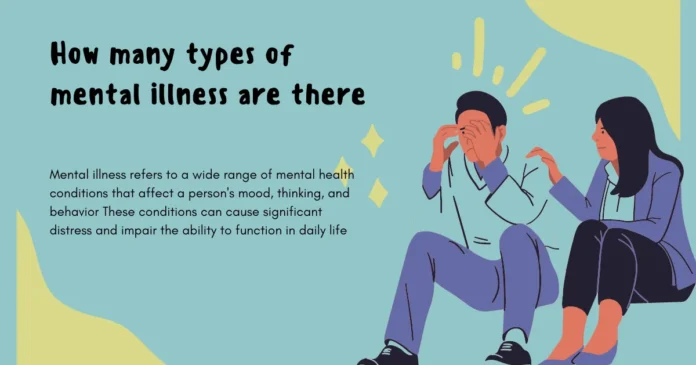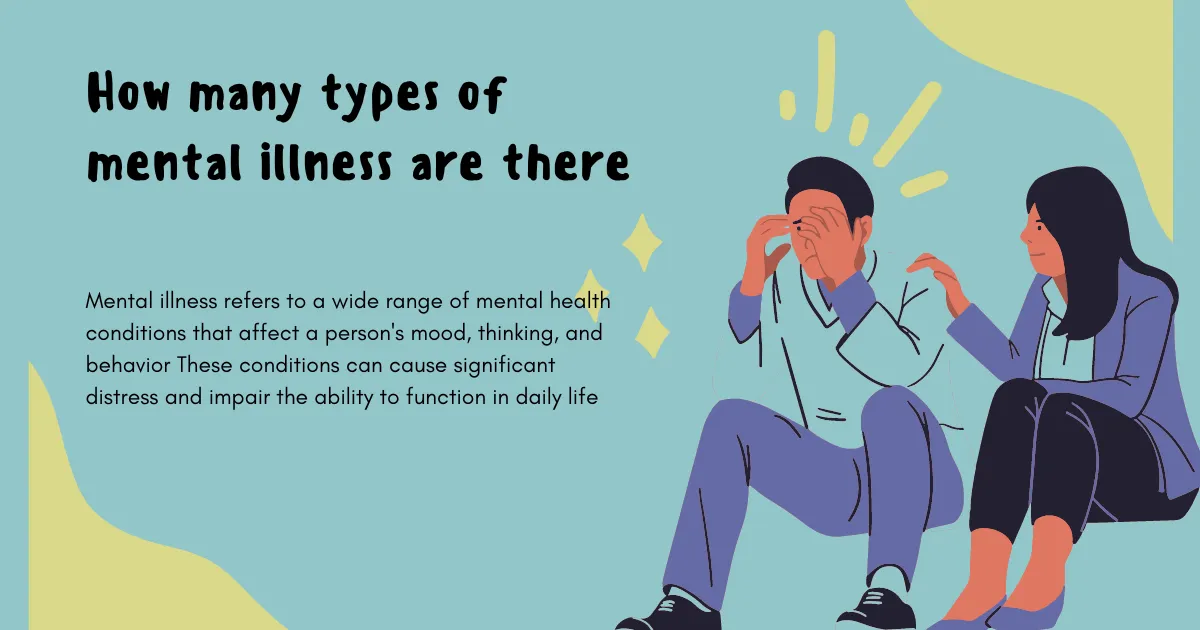How Many Types of Mental Illness Are There?
The topic of mental illness is intricate and frequently misinterpreted. It encompasses a wide range of disorders that affect mood, thinking, and behavior. Understanding the various types of mental illness is crucial for promoting mental health awareness, reducing stigma, and ensuring that individuals receive the appropriate care and support.
What is Mental Illness?
A person’s mood, thoughts, and behavior can all be impacted by a variety of mental health issues, collectively referred to as mental illnesses. These conditions can cause significant distress and impair the ability to function in daily life. Common misconceptions include the belief that mental illness is a sign of weakness or that it can be overcome through sheer willpower. In reality, mental illnesses are medical conditions that require treatment and support.
Categories of Mental Illness
Mental illnesses are categorized based on their symptoms and diagnostic criteria. Healthcare professionals use tools like the Diagnostic and Statistical Manual of Mental Disorders (DSM-5) to diagnose and classify mental health conditions. These categories help in understanding the specific challenges faced by individuals and in determining the most effective treatment plans.
Anxiety Disorders
The hallmark of anxiety disorders is overwhelming fear or anxiety that gets in the way of day-to-day activities. These disorders include:
Generalized Anxiety Disorder (GAD)
GAD involves persistent and excessive worry about various aspects of life, such as work, health, or social interactions.
Panic Disorder
Panic Disorder is marked by sudden and recurrent panic attacks, which are intense periods of fear accompanied by physical symptoms like heart palpitations and shortness of breath.
Social Anxiety Disorder
Social Anxiety Disorder involves an intense fear of social situations and being judged or scrutinized by others.
Specific Phobias
Specific phobias are irrational fears of specific objects or situations, such as heights, animals, or flying.
Mood Disorders
Mood disorders primarily affect a person’s emotional state. These include:
Major Depressive Disorder
Major Depressive Disorder is characterized by persistent feelings of sadness, hopelessness, and a lack of interest in activities once enjoyed.
Dysthymia
Dysthymia, or persistent depressive disorder, is a chronic form of depression with less severe but long-lasting symptoms.
Psychotic Disorders
Psychotic disorders involve distorted thinking and awareness. They include:
Schizophrenia
Schizophrenia is a severe mental disorder characterized by hallucinations, delusions, and impaired thinking and behavior.
Schizoaffective Disorder
Schizoaffective Disorder combines symptoms of schizophrenia with mood disorder symptoms, such as depression or mania.
Eating Disorders
A preoccupation with food, body image, and weight is a feature of eating disorders. Types include:
Anorexia Nervosa
An obsession with food, weight, and body image is a characteristic of eating disorders.
Personality Disorders
Persistent behavioral, cognitive, and subjective experience patterns are hallmarks of personality disorders.. These include:
Borderline Personality Disorder
Borderline Personality Disorder involves instability in relationships, self-image, and emotions, often resulting in impulsive actions.
Antisocial Personality Disorder
Antisocial Personality Disorder is marked by a disregard for the rights of others, deceitful behavior, and a lack of remorse.
Obsessive-Compulsive and Related Disorders
These disorders involve obsessive thoughts and compulsive behaviors. Types include:
Obsessive-Compulsive Disorder (OCD)
OCD is characterized by intrusive, unwanted thoughts (obsessions) and repetitive behaviors (compulsions—and) aimed at reducing anxiety.
Body Dysmorphic Disorder
Body Dysmorphic Disorder involves an obsessive focus on perceived flaws in physical appearance, which are often unnoticeable to others.
Hoarding Disorder
Hoarding Disorder is characterized by the persistent difficulty discarding or parting with possessions, regardless of their actual value.
Trauma- and Stressor-Related Disorders
These disorders arise after exposure to a traumatic or stressful event. They include:
Post-Traumatic Stress Disorder (PTSD)
After going through or seeing a horrific experience, PTSD sets in, causing excruciating anxiety, nightmares, and flashbacks.
Acute Stress Disorder
Acute Stress Disorder occurs in the immediate aftermath of a traumatic event, with symptoms similar to PTSD but shorter in duration.
Neurodevelopmental Disorders
Neurodevelopmental disorders typically manifest early in development and include:
Autism Spectrum Disorder
Autism Spectrum Disorder involves challenges with social interaction, communication, and repetitive behaviors.
Attention-Deficit/Hyperactivity Disorder (ADHD)
Chronic patterns of hyperactivity, impulsivity, and inattention that impede functioning or development are hallmarks of ADHD.
Substance-Related and Addictive Disorders
These disorders involve the misuse of substances such as alcohol or drugs. They include:
Substance Use Disorders
Substance Use Disorders are characterized by the harmful use of substances, leading to significant impairment or distress.
Gambling Disorder
Gambling Disorder involves persistent and recurrent problematic gambling behavior that leads to significant distress or impairment.
Mental Illness’s Effect on Everyday Life
Mental illness can affect every aspect of a person’s life, including work, relationships, and physical health. It can lead to social isolation, reduced productivity, and increased physical health problems. Understanding and supporting those with mental illness is crucial for fostering a compassionate and inclusive society.
Treatment and Management of Mental Illness
Treatment for mental illness varies depending on the type and severity of the condition. Common treatments include:
- Therapy: Various forms of psychotherapy, such as cognitive-behavioral therapy (CBT), can help individuals manage symptoms and develop coping strategies.
- Medication: Medications, such as antidepressants and antipsychotics, can be effective in managing symptoms.
- Lifestyle Changes: Regular exercise, a healthy diet, and sufficient sleep can have a positive impact on mental health.
- Support Networks: Support from family, friends, and support groups is essential for recovery and ongoing management.
Conclusion
Understanding the many types of mental illness is essential for promoting mental health awareness and providing the necessary support and treatment. By educating ourselves and others, we can work towards reducing the stigma surrounding mental illness and fostering a more understanding and supportive society.
FAQs OF Types of mental illness
What is the most common mental illness?
The most common mental illness is anxiety disorder, which affects millions of people worldwide.
Can mental illness be cured?
While many mental illnesses cannot be “cured,” they can often be effectively managed with the right treatment and support.
Are mental illnesses genetic?
Many mental illnesses have a genetic component, meaning they can run in families, but environmental factors also play a significant role.
What should I do if I think I have a mental illness?
If you think you have a mental illness, it’s important to seek help from a healthcare professional who can provide a proper diagnosis and treatment plan.




